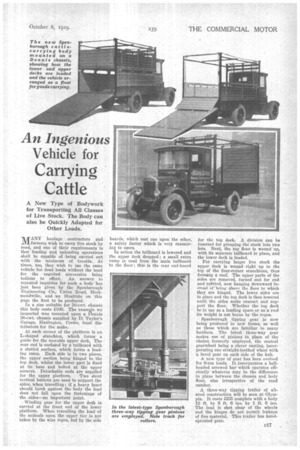An Ingenious Vehicle for
Page 55

If you've noticed an error in this article please click here to report it so we can fix it.
Carrying Cattle
A New Type of Bodywork for Transporting All Classes of Live Stock. The Body can also be Quickly Adapted for Other Loads.
]\Ifr.A.NY haulage contractors and ANY wish to carry live stock by road, and one of their requirements is that loading and unloading operations shall be capable of -being carried out with the minimum of trouble. At times, too, they wish to use the same vehicle for dead loads without the need for the required conversion being tedious to effect. An answer to repeated inquiries for such a body has just been given by the Spenborough Engineering Co., Union Road, Heckmondwike, and we illustrate on this page the first to be produced.
In a size suitable for 30-cwt. chassis this body costs £100. The example we inspected was mounted upon a Dennis 30-cwt. chassis supplied by D. Taylor's Garage, Haslington, Crewe, local distributors for the make.
At each corner of the platform is an L-shaped stanchion, which forms a guide for the movable upper deck. The rear end is enclosed by a tailboard with a slatted surface, which forms a loading ramp. Each side is in two pieces, the upper section being hinged to the top deck, whilst the lower part is fixed at its base and bolted at the upper corners. Detachable ends are supplied for the upper platform. Two stout vertical battens are used to support the sides, when travelling; if a heavy beast should lurch against the body the load does not fall upon the fastenings of the sides—an important point.
Winding gear for the upper deck is carried at the front end of the lower platform. When travelling the load of the animals upon the upper tier is not taken by the wire ropes, but by the side boards, which rest one upon the other, a safety factor which is very reassuring to users, In action the tailboard is lowered and the upper deck dropped ; a small extra ramp is used from the main tailboard to the floor ; this is the rear end-board for the top deck. A division can be inserted for grouping the stock into two lots. Next, the top floor is wound up, with its separate tailboard in place, and the lower deck is loaded.
For carrying larger live stock the upper deck is wound right up to the top of the four-corner stanchions, thus forming a roof. The upper parts of the sides are removed, turned end for end and refitted, now hanging downward instead of'heing above the floor to which they are binged. The lower sides are in place and the top deck is then lowered until the sides make contact and support the floor. Whether the top deck be in use as a loading space or as a roof its weight is not borne by the ropes.
Spenborough tipping gear is now being produced in new forms, as well as those which are familiar to many hauliers. The latest three-way gear makes use of pinions in place of the chains formerly employed, the central gearwheel being a clever casting, incorporating one straight-toothed wheel with a bevel gear on each side of the hub.
A new type of gear has been evolved for 6-ton loads. It incorporates a ballheaded screwed bar which operates efficiently whatever may be the difference in plane between the chassis and body floor, also irrespective of the road camber.
A three-way tipping trailer of allsteel construction will be seen at-Olympia. It costs £235 complete with a body 12 ft. by 6 ft. 6 ins. by 1 ft. 6 ins. The load is shot clear of the wheels and the hinges do not permit leakage of fine material. This trailer has handoperated gear.




























































































































